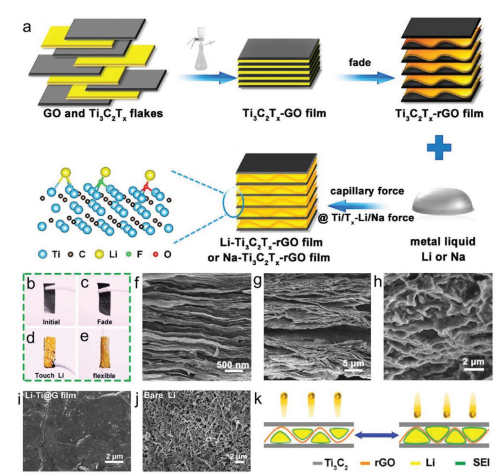已传文件:photo/1631586161.png
North Konami provides MXene materials (customizable)


Metal anodes such as Li, Na, K, Zn, Mg, Ca, Al, and Fe have received extensive attention in the past few years due to their high theoretical specific capacity, low electrochemical potential, and excellent Electronic conductivity. Metal anodes can be matched with cathodes to prepare high-energy-density rechargeable metal batteries. However, some inherent problems such as large volume expansion, uncontrolled growth of dendrites, and unstable solid-electrolyte interfaces hinder the further development of rechargeable metal batteries. MXene, an emerging 2D material, has shown great potential to address these problems, thanks to its 2D structure, abundant surface functional groups, and ability to assemble into macroporous structures. To date, various strategies have been proposed with the aid of MXenes and used to achieve stable dendrite-free metal anodes, such as MXene-based host design, design of metal-philic MXene-based substrates, improvement of metal surfaces with MXenes, Design MXene arrays and modify separators or electrolytes with MXenes, etc. Recently, Professor Jinkui Feng of Shandong University published a review article entitled: Recent Advances of Emerging 2D MXene for Stable and Dendrite-Free Metal Anodes in the international high-level academic journal Advanced Functional Materials, summarizing the application of MXene materials in stable dendrite-free metal anodes research progress and prospects for future research directions.


Figure 1. Application of MXene in stable and dendrite-free metal anodes.


Figure 2. Synthesis process and corresponding characterization of Ti3C2-Li composite anode.

Figure 3. Synthesis process and corresponding characterization of Li-Ti3C2Tx-rGO composite anode.

Figure 4. Synthesis process and corresponding characterization of the MG-Li composite anode.

Figure 5. Synthesis process and corresponding characterization of Li-rGO/Ti3C2Tx composite anode.
Figure 6. Schematic diagram and associated characterization of Zn-MXene and Li nucleation and growth behavior on copper foil.

Figure 7. Synthesis process and related characterization of flexible 2DSi@MXene films.
Figure 8. Synthesis process and corresponding characterization of PA-MXene-Cu.
Figure 9. Representative MXene-based supercapacitor device. Synthesis process and characterization of N-Ti3C2/C@PP separator.
Figure 10. Synthesis and characterization of MCPEs.
Figure 11. Synthesis process and characterization of the flexible self-supporting Ti3C2Tx MXene@Zn paper composite anode.
Figure 12. Future research directions of MXenes in metal anodes.
Overall, this paper summarizes the research progress of 2D MXenes for stabilization of dendrite-free metal anodes. The application of MXene materials in metal anodes is increasing year by year. As a new type of multifunctional 2D material, it can well solve the essential problems of metal anodes. However, the research and application of MXene in metal anodes is still in the initial stage, and there are still many works worth studying in the future. i) Increase the diversity of synthetic methods when MXenes are used in metal anodes; ii) Design more MXene-based host structures for metal anodes; iii) Improve MXenes with liquid electrolytes; iv) Explore the application of MXenes in more metal anodes ; v) Design diverse flexible MXene/metal composite anodes; vi) Evaluate practical application capability; vii) Recycling technology; viii) Integrate with advanced technologies.
Literature link:
https://doi.org/10.1002/adfm.202004613












